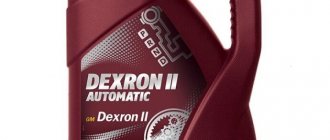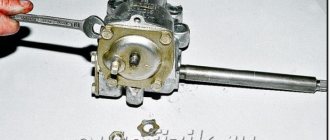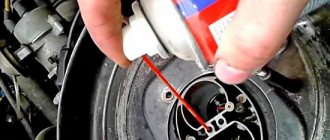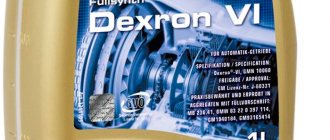Very often the question arises about the interchangeability of Dextron II and Dextron III. There are two opinions on this matter:
• Dexron III is the same as Dexron II, but with improved characteristics, and if you mix it with Dexron II, nothing bad will happen. In general, the ATF that can be poured into the machine should be no lower than that indicated on the dipstick. That is, if Dexron II is indicated on the dipstick, then both II and III (and higher) can be poured, but if III is indicated, then II cannot be poured. • Since the characteristics of Dexron III still differ from the characteristics of Dexron II, this may affect the operation of the automatic transmission, and not for the better. II and III differ in viscosity, and significantly, and this greatly changes the pressure in the automatic transmission system, which plays a big role in the operation of the box. • Conclusion, it is recommended to fill only what is indicated on the dipstick or in the car’s instructions. Variations are possible only with respect to the manufacturer. Otherwise, over time, experiments with mixing Dexron may have a detrimental effect on the automatic transmission of your car.
In this case, it is necessary to take into account several nuances. For example, when choosing an ATF, its color should in no way be the deciding factor. The color of ATF depends only on the dye and is needed for quick identification. It also does not matter what type of oil - synthetic or mineral. Unlike an engine, in an automatic transmission you can mix mineral water with synthetics without detrimental consequences for the operation of the machine. And you need to remember that some automakers (for example, Honda and Mitsubishi) strongly recommend using not just any oil in automatic transmissions, but only special fluids, otherwise normal operation of the automatic transmission is not guaranteed by the manufacturer.
Hydraulic power steering is designed to make steering easier, as well as dampen vibrations and shocks that occur on the steering wheel. In order for it to last a long time and work stably, it is necessary to regularly change the oil in it and monitor its quality. The article discusses Dextron oils, including Dextron 3 for power steering, and gives their description, advantages and disadvantages.
Description of the liquid
The power steering design consists of several mechanisms, which are visible in the diagram.
Power steering diagram for cars
The entire mechanism is washed by a special hydraulic fluid (PSF).
It has the following functions:
- transmits pressure from the pump to the piston;
- has a lubricating effect;
- has anti-corrosion properties;
- cools the components and mechanisms of the unit.
Thanks to the power steering oil, which circulates in a closed circuit, the created pressure is transferred from the pump to other components of the unit. When high pressure is created in the pump, PSF enters the low pressure zone where the SGC pistons are located. The cylinder is connected to the steering wheel rack using a spool. Depending on the position of the steering wheel, the spool directs oil, making it easier to turn the steering wheel.
An important function of PSF is to remove excess heat from mechanisms. In addition, acting as a lubricant, it reduces friction between moving components. Anti-corrosion additives in the composition prevent rust from forming inside the mechanism.
Compound
PSFs are divided into three types:
- mineral;
- semi-synthetic;
- synthetic.
Mineral ones contain 97% naphthenes and paraffins, the rest are additives that impart certain properties. Semi-synthetics contain both mineral and synthetic components. They have a longer service life and better performance. Synthetic PSF contains polyesters, hydrocracked petroleum fractions, and polyhydric alcohols. In addition, they contain additives that improve its properties.
PSF contains the following additives:
- to reduce friction between parts;
- against corrosion processes;
- viscosity stabilizing;
- acidity stabilizing;
- giving color;
- preventing foaming;
- to protect rubber parts.
When choosing power steering oil, you should pay attention to the composition and technical characteristics (video author - Vladislav Chikov).
Advantages and disadvantages
Each type of working fluid has its own advantages and disadvantages:
| Type PSF | Advantages | Flaws |
| Mineral |
| |
| Semi-synthetic |
| |
| Synthetic |
|
Dextron red
Interchangeability and miscibility
The manufacturer introduced the qualification of power steering fluids by color by adding coloring pigments to their composition: red, yellow and green. Red power steering oils are developed according to General Motors standards; they are called Dextrons.
Specifications
All the most important technical characteristics are presented in the table, from which you can determine how suitable the oil is for your needs.
| Indicator name | ZIC ATF 2 |
| Country of Origin | South Korea |
| Transmission type, other applications | automatic transmission; power steering |
| Type of oil | synthetics |
| Color | red |
| Viscosity SAE | — |
| Density at 15 °C, g/cm3 | 0,84 |
| Kinematic viscosity at 40 °C, mm2/s | 36,9 |
| Kinematic viscosity at 100 °C, mm2/s | 7,3 |
| Viscosity index | 168 |
| Flash point, °C | 226 |
| Pour point, °C | -47,5 |
| Acid number, mg KOH/g | 1,48 |
| Corrosive effect on copper at 100 °C/3 h, point | 1-a |
| Brookfield viscosity at -26°C, MPa*s | 2689 |
Specifications, approvals and approvals
Complies with modern tolerances and has approvals for use in cars:
- Allison: C-3;
- Cat: Caterpillar TO-2;
- Ford: Mercon;
- General Motors: GM Dexron 2.
Analogues: comparison table
Sometimes it happens that the required oil is not available, so you have to urgently look for a replacement in the form of analogues with identical characteristics.
| Oil | Analogs |
| All oils presented are analogues of ZIC ATF 2 | Castrol ATF Multivehicle |
| Eneos Eco ATF | |
| Idemitsu ATF Type | |
| Liqui Moly ATF Top Tec | |
| Mannol ATF WS Automatic Special | |
| Mitasu MJ-331 ATF WS Synthetic Tech | |
| Neste ATF-X | |
| Petro-Canada DuraDrive MV Synthetic | |
| Ravenol ATF Type | |
| Shell Spirax S5 ATF X | |
| Totachi ATF TYPE | |
| Total FLUIDE XLD FE | |
| Wolf OfficialTech ATF | |
| Xado Atomic Oil ATF | |
| ZF LifeguardFluid |
Dexron 2 and Dexron 3
The automatic transmission uses DEXRON-2 oil. On ancient cars 95 and older, DEXRON-II D was used, it is mineral-based; on more recent cars, DEXRON-2 E or DEXRON-III is used. In Toyotas, you can read on the oil dipstick what is pouring into the box. In any case, you should not mix mineral- and synthetic-based liquids.
In Japanese cars, it is enough to know which dexton is suitable for your machine and you can safely pour it, but some owners of old cars face difficulties in finding DEXTRON2D2E. In a car with DEXTRON2D written on the dipstick, ONLY DEXTRON2D can be poured, while in machines using DEXTRON2E it can be replaced with DEXTRON3 (but not back, if the automatic transmission requires D3; it cannot be replaced with D2E). All negative opinions about such a replacement are related to the fact that Dextron3 has greater fluidity than its predecessor, this has a beneficial effect on the properties of the automatic transmission in the cold period, but due to the fact that on some old automatic transmissions the gaskets are not designed for this level of automatic transmission oil viscosity, they leak slightly, this is not a problem in itself, unless, of course, you allow the oil to leak below the minimum level, in any case it is recommended to change the gaskets , or periodically add a little D3.
About the color of the automatic transmission fluid (Note that I specifically said fluid, not oil!) Many determine the choice of fluid by color, in vain! The color is just dyes that manufacturers add at the factory to make it easier to find smudges, and the difference in color shows what basis the ATF is made from. The yellow color of ATF indicates that the automatic transmission is filled with synthetic-based fluid, and red indicates the mineral composition of the fluid. Matching the type of liquid is much more critical than its color. Until recently, it was believed that it was impossible to mix automatic transmission fluids on the same principle as motor oils, because when operating temperatures are reached, motor oil with different bases mixed in this way coagulates.
It is worth dispelling this misconception because 1-In an automatic transmission there are no such loads under which the oil could curdle. 2-In an automatic transmission, it is not OIL that is used, but transmission fluid on different bases, and mixing it does not cause any harm to the automatic transmission (and people simply call it Oil out of habit). On the other hand, it’s better not to experiment with something as expensive to repair as an automatic transmission, especially since finding fluid on the right base is not difficult these days, so you shouldn’t retrain the automatic transmission to a different base, it’s better to pour what it’s used to because You will not get any benefits from changing oils of different bases. (Remember: You can replace Dextron 2 with Dextron3, but not vice versa!), buy oil only in RELIABLE places and do not skimp on it, the automatic transmission is not the part of the car that tolerates this!
By the way, the same applies to hydraulic boosters on old cars (For those who don’t know, you need to pour the same oil into the power steering as in the automatic transmission), which also tends to give a small leak when using Dextron3 instead of Dextron2E.
How to spot a fake
Products of well-known brands are often counterfeited, mainly in the highest price category. But there are frequent cases of counterfeit products in the middle price segment. Therefore, before going to the store, you should know about the verification method provided by the manufacturer.
To combat counterfeiting, the Mobile company has developed a special protection system in the form of a hologram with numbers. Knowing about it, you can easily distinguish the original Mobil Dexron VI ATF from a fake:
- The canister must have a hologram with numbers and protruding dots on them. Nearby is a QR code for scanning with a mobile phone;
- The mobile phone must be connected to the Internet, after which you can scan;
- After scanning, exactly the same grid with numbers and raised dots should appear on the mobile screen as on the canister;
- If everything matches, click “yes”, an inscription will appear that the product is genuine;
- If it is not possible to scan the QR code, you can go to the website indicated on the label via a computer. Enter the 12-digit original code and click “check”.
Characteristics of Dexron 2 and 3 oils for power steering, is it possible to pour and mix?
Hydraulic power steering is designed to make steering easier, as well as dampen vibrations and shocks that occur on the steering wheel. In order for it to last a long time and work stably, it is necessary to regularly change the oil in it and monitor its quality. The article discusses Dextron oils, including Dextron 3 for power steering, and gives their description, advantages and disadvantages.
Description of the liquid
The power steering design consists of several mechanisms, which are visible in the diagram.
Power steering diagram for cars
The entire mechanism is washed by a special hydraulic fluid (PSF).
It has the following functions:
- transmits pressure from the pump to the piston;
- has a lubricating effect;
- has anti-corrosion properties;
- cools the components and mechanisms of the unit.
General Motors' role in creating the first ATF
By the end of the 40s, automatic transmissions had become a common part of cars. And it is not surprising that the first ATF oil for automatic transmissions was created by General Motors specialists. This was the world's first transmission fluid specification. It was called Type A. The liquid was created in 1949. Then GM began to develop transmission oils, and later to classify them and put forward the most stringent requirements for them. Products that were created in General Motots laboratories, due to the lack of competition, have become the international standard for working fluids for any type of automatic transmission.
Dextron - Difference between ATF Dexron 2 and 3? — 22 answers
Dextron
In the Service, Maintenance, Tuning section, answer the question: Is there a difference between ATF Dexron 2 and 3? asked by the author Evgeniy Davidenko, the best answer is Dextron 3, this is simply a further development of Dextron 2. The automatic transmission uses DEXRON-II oil. On ancient cars 95 years old and older, DEXRON-II D was used, it is mineral-based; on more recent cars, DEXRON-II E or DEXRON-III is used. In Toyotas, you can read on the oil dipstick what is pouring into the box. In any case, you should not mix mineral- and synthetic-based fluids. In Japanese cars, it is enough to know which dexton is suitable for your machine and you can safely pour it, but some owners of old cars face difficulties in finding DEXTRON2D2E. In a car with DEXTRON2D written on the dipstick, you can pour ONLY DEXTRON2D, while on machines using DEXTRON2E it can be replaced with DEXTRON3 (but not vice versa, if the automatic transmission requires D3, it cannot be replaced with D2E). All negative opinions regarding such a replacement are related to the fact that Dextron3 has greater fluidity than it predecessor, this has a beneficial effect on the properties of the automatic transmission in the cold period, but due to the fact that on some old automatic transmissions the gaskets are not designed for this level of automatic transmission oil viscosity, they leak slightly, this is not a problem in itself, unless of course If the oil leaks below the minimum level, in any case it is recommended to either change the gaskets or periodically add a little D3. The yellow color of ATF indicates that the automatic transmission is filled with synthetic-based fluid, and red indicates the mineral composition of the fluid. Remember: You can replace Dextron 2 with Dextron3, but not vice versa! The automatic transmission is not the part of the car that tolerates this! By the way, the same applies to hydraulic boosters on old cars, which also tend to give a small leak when using Dextron3 instead of Dextron2E.
Video “Power steering oil”
This video gives an overview of the PSF Dextron III (the author of the video is Nik86 auto-construction).
The legislator in the field of setting standards is General Motors (GM), whose specifications are used by both ATF manufacturers and automatic transmission manufacturers. In the 80s, the current GM specification was Dextron IID and it is not difficult to guess that the “automatic” for cars of those years was designed taking into account the requirements of this particular specification. Those. Materials and design were calculated based on the assumption that the working fluid would be ATF meeting the Dextron IID standard. But new requirements for automatic transmissions are emerging, new materials and production technologies are being developed. ATF standards are also changing. Dextron IIE and the current specification, Dextron III (adopted in 1993), appeared. The only differences between Dextron IIE and Dextron IID are the viscosity at low temperatures. Those. at the operating temperature of the automatic transmission, there are practically no differences, except that IIE has greater stability of properties over its service life, since it is a completely synthetic fluid, and IID has a mineral base. However, at the beginning of work, until the box has warmed up, the differences are very significant - the viscosity of Dextron IID at -40°C is 45,000 mPa s, and Dextron IIE at the same temperature is 20,000 mPa s. Those. When the engine is cold, it is much easier to turn the automatic transmission with Dextron IIE. But between Dextron IID(E) and Dextron III, the differences are already in friction properties, which affects the operation of the automatic transmission in all operating modes.
Based on interchangeability, dextrons are grouped into groups, depending on equipment requirements:
— Dextron III replaces Dextron II (but not vice versa) if the equipment allows an increase in friction-reducing modifiers. This includes GM automatic transmissions.
— Dextron III does not replace Dextron II if the equipment does not allow a reduction in the coefficient of friction by increasing the efficiency of the modifiers.
— Dextron IIE replaces Dextron IID on any equipment (but not vice versa), because does not differ in the effectiveness of modifiers, and, in fact, is Dextron ohm IID, but with improved low-temperature properties.
Practice. What do all these vague differences in low-temperature and friction properties mean in practice? Here's what. Dextron IID is not designed for use in severe cold winter conditions. It is suitable for regions where -15 does not happen often. Those. the south of the European part of Russia, Ukraine and non-northern Europe can pour it on a budget and not bother with the agony of further choice. Where temperatures sometimes reach -30, and -15 is not uncommon, you will have to choose between Dextron IIE and Dextron III, since they have more suitable viscosities at low temperatures. For those who followed the progress of the previous discussions, it is already obvious that in theory one should choose Dextron IIE - the box was originally designed for it, it behaves no worse in the cold, so what’s the problem? The problem is that the current specification is Dextron III, and all ATF manufacturers are focused on mass production of Dextron III. And for older cars they continue to produce Dextron IID. Why IID and not IIE? Because Dextron IIE is really needed only in the northern regions (where the bulk of the machines are not concentrated at all), >> and its production costs (let me remind you that it is a completely synthetic product) 2-3 times more expensive. In other words, it makes economic sense for the ATF manufacturer to divide the entire fleet of vehicles into those who need Dextron IID and those who need Dextron III. The transition point from II to III is usually taken as 1996. Here they (manufacturers) are also well helped by the fact that GM (remember this one) allows the replacement of ITS equipment Dextron II with Dextron III. That’s all, we can safely recommend it to those who need good low-temperature properties of Dextron III instead of the “native” Dextron II. Or maybe that’s how it should be? Here everyone decides for himself. I will only give the possible practical consequences of replacing Dextron II with Dextron III, in the case where the equipment does not allow a decrease in the friction properties of ATF.
TOTAL
If during traditional examinations of gasoline and motor oils we, as a rule, identified only minor differences between one sample and another, here the situation is different. In terms of key parameters, the difference between different ATFs turned out to be significant. And if you consider that the degree of influence of this complex fluid on power, fuel consumption, and the resource of the box is very noticeable, then you should think about its choice. Good synthetics with a high viscosity index are the best choice, which will protect your nerves during winter starting in fairly cold weather, and will not create problems after a long stay in a traffic jam under the sultry sun.
The extent to which Multi matches its name will be left to the conscience of its developers. At the very beginning, we noted that it is unrealistic to test in practice every ATF in all the “machines” listed on their labels. By the way, in the descriptions (with a few exceptions) tolerances are either directly or by default designated by the word meets, that is, “corresponds.” This means that the properties of the liquid are guaranteed by its manufacturer, but there is no confirmation of compliance by the manufacturer of the car or box. In conclusion, we would like to inform you that if the planned service life of a new car does not exceed 50–70 thousand kilometers (then a replacement is planned), then you read the article in vain - you will not have to change the “liquid clutch”. In other cases, the information we have obtained should be useful. Adding up the results obtained in all tests, we found that the best products were Motul and Mobil, with Formula Shell liquid lagging behind slightly.
Our comments on each drug are in the photo captions.
How is ATF different from other gear oils?
To understand the difference, you need to approach the issue from afar. Cars use oils for engines, gearboxes, hydraulic boosters and ATF oil. What are the similarities between all these liquids? These oils are based on hydrocarbons, which are obtained through the processing of fossil fuels. This gives some similarities in characteristics. All of the above products have lubricating properties and increase slip between rubbing surfaces.
Also, all these liquids have good heat removal characteristics. They are similar in consistency. This is where all the similarities end. This sometimes causes serious mistakes when a novice car enthusiast fills the automatic transmission with manual oil and the power steering with brake fluid.
Basic properties of ATF
ATF oil is one of the most complex fluids in its composition among all lubricating mixtures used in a modern car. High demands and standards are imposed on such a lubricant. The oil must have a lubricating effect - due to this, friction is reduced, and at the same time wear in the gearbox elements is reduced. In this case, the friction forces in the friction groups should increase. This will reduce slippage of brake bands and other components.
Also one of the important properties is heat dissipation. The oil has high thermal conductivity and fluidity characteristics. In this case, the liquid should not foam during operation. An important point is stability, namely the absence of oxidation processes when heated to high temperatures at the moment of contact with oxygen. Additionally, the oil must have anti-corrosion properties. This is necessary in order to prevent the formation of corrosion on the internal components of the mechanism. Automatic transmission fluid must be hydrophobic (this is the ability to push moisture out of the surface). In this case, it is necessary that the liquid retains its fluidity and hydraulic characteristics. ATF grease has stable characteristics and a high compression ratio over the widest possible temperature range. Another point is the decrease in penetrating ability through the automatic transmission and the presence of dye.











